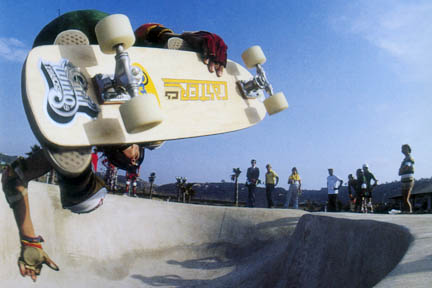

|
Surfing on dry land
My first skateboard was a piece of plywood with metal wheels purchased from Wigwam in Kailua for a dollah t'ree-eighty. It was my ticket to adventure, and it allowed me to surf the sidewalks when the waves were junk.
|
"The Legacy of Warren Bolster, Master of Skateboard Photography" (Concrete Wave Editions, $39.95 hardcover, 160 pages; available at Borders and surf and skate shops)
|
The current generation of skateboarders is performing mind-boggling tricks, going airborne on sophisticated boards composed of high-tech man-made materials or multilaminate exotic hardwoods, with urethane wheels attached to responsive trucks that allow complete freedom of movement.
The most gifted skaters are even making good money competing in international events and signing rich endorsement deals.
But they never would have ascended so high without the groundbreaking work of the bold skaters of the '70s and '80s.
Those early skaters riding comparatively barbaric equipment pushed the limits of performance, enabling this current lucrative era of professional skating to develop. And photographer and then-skating magazine editor Warren Bolster was their most prolific chronicler.

|
This book is filled with heartfelt testimony from skateboarding's prime players about how Bolster's coaching, dedication and astounding photos prodded them to perform at breathtaking levels. But mostly, this book is filled with Bolster's images, a dazzling mix of moody art in action and in-your-face frames that make the viewer reflexively duck to avoid being hit by board and rider.
Bolster was lured away from surf photography to revive SkateBoarder magazine in 1974 to catch the new wave of skateboarding's revival after the previous wave of skating enthusiasm had crested and ebbed in the '60s.
Bolster was up for the task, tackling his assignment with his usual maniacal zeal, putting in 18-hour days shooting, writing, editing and designing the magazine.
His technical daring and innovation with the camera included early use of fisheye lenses, strobe flashes, motor-drive sequences and daring perspectives that involved a reckless disregard for personal safety. This earned him numerous contusions and lacerations, and wonderfully unique angles captured on film.

|
Hawaii is given props in a segment on Wallos, while throughout the book the era's legends are highlighted in their prime, including Tony Alva, Mike Weed, Jay Adams, Gregg Weaver, Bruce Logan, the Dogtown boys, Tom Inouye, Hawaiian superstar Larry Bertlemann and wahine skaters Ellen Berryman, Ellen O'Neal, Laura Thornhill and Kim Cespedes.
Incredible acrobatics, swimming-pool assaults and seemingly suicidal downhill speed runs were frozen by Bolster's camera to provide an incongruous portrait of athletic beauty that inspired the fevered dreams of young skaters worldwide.
Bolster's visions of riders flying through giant concrete irrigation pipes are like hallucinations glimpsed through shimmering Arizona desert heat waves.
The photos are enhanced by detailed captions that provide historical context and juicy tidbits, and chronicle the birth of the now ubiquitous double-kicked deck of performance skateboards, homemade transportable fiberglass waves, skate parks and ramps for full-on rampaging.

|
Bolster's words, and those of the riders whose quotes are scattered through this book, offer a rare glimpse into Bolster's soul, revealing how his generosity, enthusiasm, sacrifice and aloha for his fellow skaters inspired generations of skaters.
His true genius as a photographer and writer was to capture the essence of what it feels like to surf on dry land, and to help youngsters bring out performances and abilities they didn't realize they possessed.
It would be impossible to quantify all the skaters Warren's words and images have stoked through the years, but it's safe to say their name is legion.

Click for online
calendars and events.